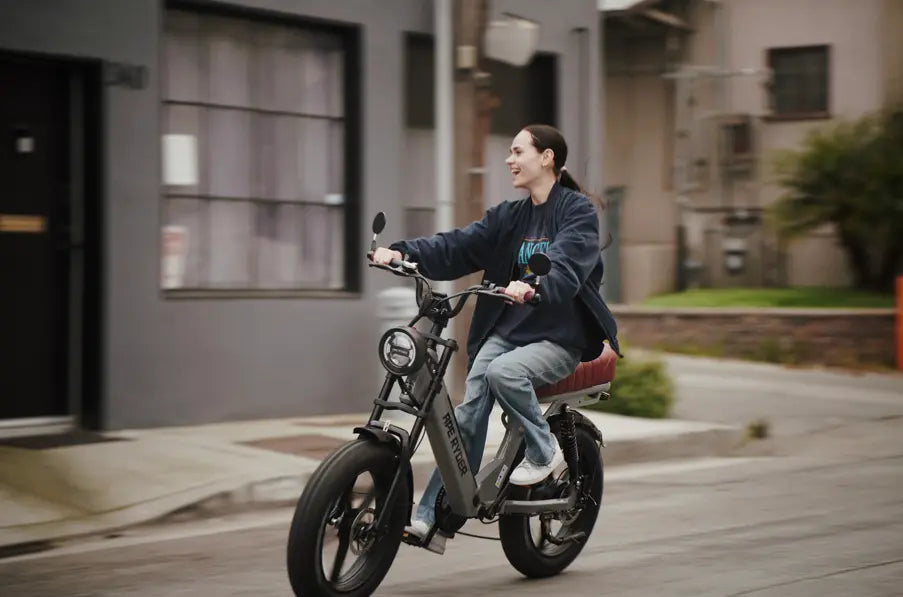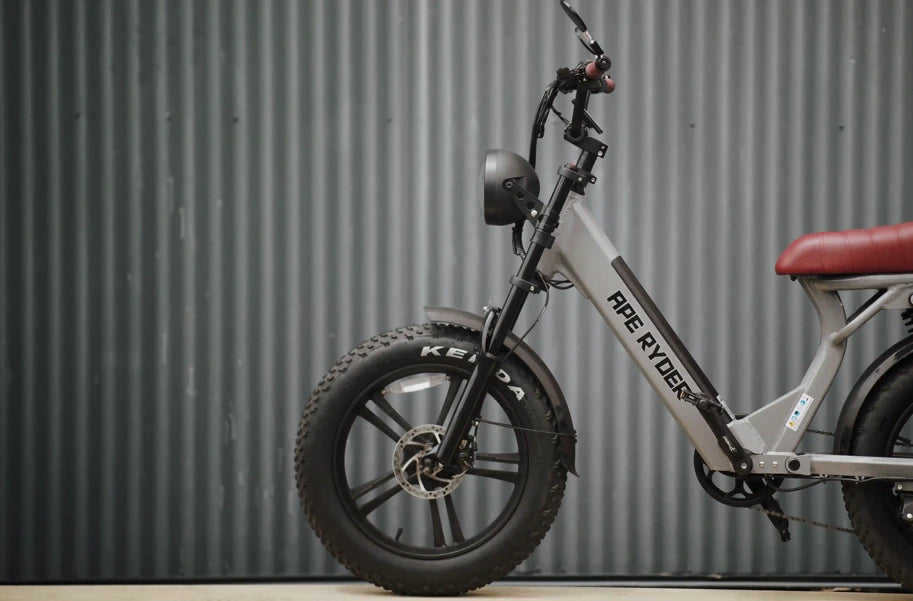The top trends for bike technologies in the year 2025 will step up with innovation cascading on waves of sustainability and comfort in the cycling experience. In particular, the latest trends in their development highlighted what the industry did: push limits with technology, ensuring riders enjoy even greater efficiency, comfort, and environmental benefits. From e-bikes to smart connectivity, the future of cycling is here and now, sure to make riding just better, greener, and more intelligent.
Let's take a look at our all e-bike models after reading the list!
1. Bike Smart Integration and Connectivities
Today, the bicycle touts smart sensors and GPS; mobile apps track everything from performance to navigation to safety, making them considerately more sophisticated and connected. Wi-Fi bikes have smartphone and wearable connectivity to feed real-time data to the rider, encased in deep analytics. Cycling as an activity is increasingly turning from a pure workout to a highly technologically intensive sport. Indeed, such rapid progress does make the future of cycling as a sport quite exciting.
Systems like Garmin, Wahoo, and Hammerhead let cyclists create much more detailed training programs for themselves. They get such great insight from those features that it further enhances and pushes new boundaries to make each ride better. These are tools that take performance higher for an individual and make it personal and precise. Moreover, social interactions become hotter since the sharing of data and experiences among cyclists drives others. Thus, the monitoring of the performance of the cyclists has completely changed with the advent of technology. It will be more interesting to see how this data influences or takes the cycling community to a whole new level.
2. Advanced E-Bikes
Inventions in e-bikes get better with an increased life of the battery, lighter frames, and stronger motors. High-performance e-bikes serve the needs of today's in-city commuters and off-road thrill-seekers. Such features as pedal assist contribute to smoother, more comfortable rides, further encouraging more people to take up cycling. What is more, such facilities make biking possible for those people who otherwise could find conventional biking a struggle. Generally great, just getting more people to get on a bike and enjoy biking.
E-bikes continue to diversify into more practical uses-running errands around town instead of taking a car. Timing couldn't be better, with increasing demand for green modes of transportation. This opens up cycling to a much wider audience and, with urban congestion still on the rise, ebikes offer a very functional solution to choked streets. Thus, soon they can change the face of urban mobility by decreasing congestion and pollution. Besides being eco-friendly, they are cool to travel on.
3. Sustainability and Eco-Friendly Materials
Manufacturers, with growing ecological concerns, try to make the sport greener by using recycled and sustainable materials. Other new innovations include recyclable frames, biodegradable parts, and production processes designed in ways to lower carbon footprints. Green practices have been added down the complete supply chains by some firms. Such sustainability efforts meet the direction in the cycling industry and set an important example for other industries. This helps both the environment and the movement towards responsible production in general.
While sustainability does seem to gain major momentum in literally every single industry, eco-friendly bikes appeal to environmentally friendly consumers and, quite frankly, contribute much more to moving towards a greener future than cycling ever did. The trend also forces manufacturers to bring in more transparency to provide an avenue for consumers to make wiser choices about what to purchase. It is sustainable products that drive positive change in customer behavior. Interesting to observe how green-thinking innovation will set the standard for the future of the cycling market.
4. Integration of Artificial Intelligence (AI) for Safety
These days AI is embedded in many systems concerning bike safety; from detection in the case of accidents and real-time route optimization to even alerts concerning traffic flow. Equipped with AI sensors, smart helmets have the ability to detect accidents and automatically send notifications to emergency contacts for prompt interventions. On the other hand, it could be that AI will recommend a safer route since AI will monitor the flow of traffic or possible hazards. Such innovation is another protective layer for cyclists. Amazing how technology makes cycling at once even safer and more available to the masses.
AI-powered safety features provide a feeling of confidence to cyclists on congested roads because they feel supported to keep them safe. It contributes not only to individual safety but also to making the general infrastructure better with critical insights into data. Thus, AI involvement in cycling safety becomes proactive rather than trying to avoid accidents well before they can actually happen. It's exciting to think how these innovations could give completely new meanings to urban cycling and maybe be able to get more and more people to adapt to biking as a safe means of transportation.
5. Aerodynamic and Lightweight Frame Designs
The target of many new materials, coming from graphene through ultra-light carbon fiber, which offers improved aerodynamics and a light frame. Advanced designs have mainly made their way onto high-performance road and racing bikes targeted at precision and speed. Geometries will be pursued in the name of power improvement and drag reduction. Those really avant-garde materials are really pushing the envelope of what these guys can do with bikes, and it's really exciting to think about how they're going to redefine speed and efficiency.
Light frames give more speed and handling to the bike, enabling competitive cyclists to perform higher and making such bikes an important winning factor in races and long-distance events. Still more breakthroughs are foreseen as bike design goes on, since technology will go further and incorporate comfort with performance. These show how technological advancement translates into excellence in athletics. The future is exciting concerning bike design and performance when it comes to competitive cycling.
6. Wireless Drivetrain Systems
Next-gen wireless, cable-free shifting systems like SRAM's AXS and Shimano Di2 are making sure that every shift is precise and flawless, without the mess of traditional cables. Fully electronic groupsets take things even further by letting riders customize shifting patterns to match their unique riding styles. Most of these setups also connect to your smartphone, making tuning adjustments and diagnostics a breeze. But where things are really headed is full-on wireless, a game-changer that makes shifting smoother and more intuitive than ever. It's pretty amazing to see how this technology keeps pushing the biking experience forward.
These systems are also easier to maintain and make for cleaner bike setups overall. The result? Smoother, faster gear shifts that make your rides more efficient and less of a hassle. With no cables, the chances of mechanical failure drop significantly, so you can enjoy your ride without the worry of gear malfunctions. On top of that, this innovation boosts both the functionality and the sleek look of the bikes. Honestly, it's incredible how these advancements take so much of the stress out of cycling, allowing riders to focus entirely on their performance and enjoyment.
7. Smart Helmets and Wearable Technology
Advancements in helmet technology now bring designs that feature integrated lights, communication systems, and even crash detection capabilities. Some smart helmets even come equipped with Bluetooth speakers, enabling voice commands and providing navigation assistance redefining the riding experience altogether. To ensure comfort during extended wear, these helmets are self-ventilating, allowing for long rides without discomfort. Helmets have evolved from being purely protective gear to becoming multifunctional devices that enhance safety and connectivity. Truly, this is “ride safe, ride smart.”
Smart helmets take safety up a notch, combining convenience with cutting-edge technology. For the cyclist who can't imagine being disconnected while on the road, these helmets become indispensable. But beyond that, wearables are gaining traction as they continue to integrate more technology into everyday riding gear, creating better and more connected cycling experiences. It’s exciting to see how innovations like these are pushing the boundaries of safety and making cycling smarter and more accessible for everyone.
8. Personalized Cycling Experiences Using Data Analytics
Meanwhile, cycling has also turn out to be an an increasing number of individualized game-one driven by using facts analysis. Fitness apps and wearables tune vast volumes of performance metrics that enable cyclists to conform their education programs for extraordinarily specialised desires. The insights from this facts will range from nutrients to healing techniques. The capability to make the schooling applications this customized, linked with records, is going to alternate how cyclists examine fitness. Interesting, how era makes education even greater particular and effective.
Personalization makes cycling greater effective and a laugh. Data supports cyclists in putting real goals, monitoring their progress, and feeling extra accomplished as they go along. What this fashion suggests is an influx in a influenced and properly-knowledgeable cycling network that feeds off increase and development. With statistics analytics, cycling now offers with personal improvement-the dynamic is wholly new. Great, how generation permits cyclists to attain new achievements and lets in them to enjoy the game at its fullest.
9. 3D-Printed Bike Components
From custom saddles and handlebars to complete frames, three-D printing in cycling is growing rapid. Now, producers have a manner to present riders exactly what they need whilst significantly decreasing production instances. How will this transformation the world? It will open up new opportunities for precise, tailor-made motorcycle designs. This is where things begin to get sincerely thrilling: the bounds of what's viable in motorcycle layout are being stretched.
That is what cyclists would need from three-D printing: special, tailored options in step with their specifications to guide waste avoidance via on-call for manufacturing. This process supports the desires of sustainable production. None of this could be more progressive, and none as groundbreaking. How interesting it's miles to consider how three-D printing will form the future for revolutionary and eco-friendly biking.
These could be the destiny trends in cycling era which are going to make bicycles lighter, faster, smarter, and safer to similarly make bigger and elevate the ordinary cycling enjoy of enthusiasts around the arena. Maybe we can see 3D-manufactured folding e-bikes in the near future!









Leave a comment
All comments are moderated before being published.
This site is protected by hCaptcha and the hCaptcha Privacy Policy and Terms of Service apply.